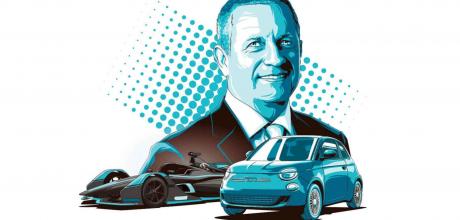Inquisition GKN boss Liam Butterworth
‘The speed of EV change is so fast’ And motorsport has a crucial role to play, says the boss of a firm quietly shaping the future
The CAR Inquisition: the man engineering the electric future
LIAM BUTTERWORTH CEO, ELECTRIC DRIVETRAIN AND PARTS MAKER GKN
Think Honda and you’re thinking frenetic fours. BMW? Sonorous sixes. Bentley? V8s with a truck’s torque. Those once distinct engineering principles have loosened of late as the car makers have had to turbocharge, downsize and hybridise. But they’ll disappear altogether in the electric era. The things actually turning an EV’s wheels need to be quiet, efficient, reliable, compact and cheap. But they don’t need to be sexy.
Car makers once created value by making the most costly part of the car: the engine. Now it’s the battery, which is most likely to be bought in, followed by the drive unit, which only around half will make in-house. That means a colossal change in the economics of the car industry, and a big-bang moment for its major suppliers. Sometimes these suppliers’ systems are so good that they become a selling point: Bosch and ZF for their fuel injection systems and gearboxes, for example. GKN, founded as the Dowlais Iron Works in Wales in 1759, now has 51 factories around the globe and typical annual sales of around £5bn. But because its main products are propshafts, sideshafts and four-wheel-drive systems, its profile is subterranean.
You may also be unaware of Liam Butterworth, GKN’s 50-year-old, Bury-born CEO and one of the British car industry’s most successful leaders. He started his career with a five-year tool-making apprenticeship at Lucas (a supplier which gained recognition for all the wrong reasons) and by 46 had floated Delphi Technologies on the New York Stock Exchange. His job now is ensuring GKN doesn’t miss out on the current disruption in car making. With 41 models already using GKN’s eDrive systems – from the new Fiat 500e to the Porsche 918 via the Ford Mustang Mach-E and the London taxi, and a lot more to come – his systems might be turning your wheels next. Does it grieve him that companies like his can engineer and build so much of our cars, yet remain unknown to most owners?
And might that change as they start to build more of them?
‘Until electrification, I don’t believe it made much of a difference that Tier 1 suppliers like us aren’t well-known to buyers,’ he says. ‘Honestly, I think electric motors will continue to be largely invisible as components, from a consumer perspective. And the car makers still won’t want their cars to be sold based on which supplier’s technology is in them.’
When car makers buy electric motors instead of building petrol ones, what do they ask Butterworth for?
‘Apart from cost? One of the big challenges they set us is refinement. The tolerances on an EV gearbox are about 10 times tighter because the OEMs want them to be completely silent, because you can hear everything. And the other area is software. Small changes in how the motor consumes power from the battery and recharges it under regenerative braking can have a real impact on the range of the vehicle.’
So although we’re all obsessed with battery capacity, some of the improvements in EV range and performance might yet come from the motor. And some of those improvements might genuinely come from motorsport.
‘We sponsor the Jaguar Formula E team,’ says Butterworth, ‘and one of the areas we’ve been working on with them is cooling the motor and gearbox, because as it gets warmer it becomes less efficient. What we’re learning is being applied to future Jaguar road cars, and to our development programmes with other OEMs. The speed of change in EVs is so fast that what we learn racing will genuinely be in road cars in three years’ time. It was the only way I could get our shareholders to say yes. I had to show that our sponsorship really is more than just an expensive sticker on the side of the car.’
But surely some car makers will still want to make the things that actually move their cars? How many marques might Butterworth’s eDrive systems actually appear in?
‘At the moment you have companies like Tesla which are amazingly vertically integrated, buying in loose parts and making almost everything themselves. And you have Chinese OEMs, say, who want one of our complete, integrated eDrive systems. But eventually things will start to normalise, and we expect around half of the major car makers to be building their own electric drive systems by 2030, if not the batteries.’ You’re very unlikely to be able to tell a Honda electric motor from a BMW one, or a GKN from a Bosch. But they’ll be fast and efficient and clean. We just need to enjoy the new silence as much as the old sounds.
Six questions only we would ask
Tell us about your first car
‘A red Mk1 Fiesta XR2. I loved that car on those pepperpot alloys.’
What is your proudest achievement?
‘It was probably with my former company, when we listed on the New York Stock Exchange in December 2017.’
Tell us about a time you screwed up
‘I’ve made a couple of bad hires in my time and it didn’t work out, so I had to let them go.’
Best thing you’ve ever done in a car?
‘I went to Ferrari’s test track in Modena four years ago and was driven in the LaFerrari by one of their test drivers.’
Supercar or classic car?
‘I’ve just taken delivery of a new Aston Martin Vantage, so that’s the kind of person I am.’
Curveball: Is the petrol engine already dead?
‘I think it will be a very prolonged, slow, gradual death, and much longer than most people currently believe.’


